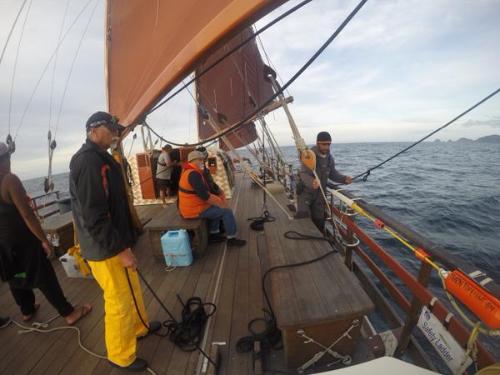Telling Tales: Adventures from Aotearoa


To the students at Campbell High School, particularly those in Punahele Kealanahele-Querubin’s Hawaiian Studies classes:
Aloha guys! I’m writing this from a platform overlooking Whangarei Harbor in New Zealand, where Hokule’a and Hikianalia float tied to the dock — and all sorts of curious onlookers are learning about these distinctive canoes from Hawaii.
When we’re not out on the water, or assigned on anchor watch to guard the canoes at night, we’re mostly staying put at local maraes. These are the special gathering places of the Maori — the indigenous peoples of New Zealand. They’ve been super generous — feeding us hearty meals and giving us a place to rest our heads at the end of these days chock full of activity.
So far we’ve stayed at two maraes. Each time we first arrived, their members greeted us with a traditional “haka peruperu” ceremony. It’s some seriously awesome stuff: The young Maori tribal members, decked in traditional garb, challenge us potential guests with intimidating wide-eyed expressions, sticking their tongues out as far as possible and stomping the ground with all the force they can muster while flexing their arms.
As we approach them, our chiefs (aka the canoes’ captains and its veteran crew) walk first, with the women behind them.
Historically this Maori haka was used to try and tell whether their visitors were friend or foe. So: if you find yourself in such a haka it’s very, very important that you stand there expressionless while your hosts size you up!
Don't miss out on what's happening!
Stay in touch with breaking news, as it happens, conveniently in your email inbox. It's FREE!
Obviously our hosts were expecting our company and knew we didn’t mean any trouble. These days, the display is a key way to help keep alive the Maori customs that stretch back generations here. It’s also a way to bond with the voyagers from Hawaii who are trying to do the same thing. Believe me, it’s a chicken-skin moment to witness.
(Still, I was glad that our pwo navigator captains, Bruce Blankenfeld, Kalepa Baybayan and Onohi Paishon, kept their poker faces on during the haka — just in case!)
As raw and intense as our Maori hosts are during the haka, they’re equally warm and inviting in the moments that follow. They love to laugh and share. A young Maori, Chey Milne, explained to me that it’s rare to find maraes in the north of New Zealand adorned with the elaborate carvings of old because the Christian missionaries who arrived here frowned upon those displays.
“Colonization had a strong impact on the northland,” Milne said. “These are very special places.”
An ornate beam in the center of the ceiling represents knowledge. Carvings of Maori ancestors, portrayed as spiritual “other beings” line the walls. At night, we sleep with our heads to the wall – a purposeful way to connect with those ancestors.
Maoris and Hawaiians have tons in common, including a shared legacy of canoe voyaging. They call their canoes “waka” while Hawaiians call theirs “wa’a.” They build their canoes with giant kauri logs, which are on the verge of disappearing, while Hawaiians used to build theirs with giant koa logs, which are now almost impossible to find.
But there’s more, too. By total coincidence, right about the latest Hokulea crews here, a special tribunal appointed by the New Zealand government here issued this huge resolution on Maori sovereignty — and to several on our crew it sounded eerily similar to Hawaii’s 1993 Apology Resolution.
In a nutshell, the tribunal found that Maori leaders did not give up their sovereignty when they signed what’s known as the Treaty of Waitangi all the way back in 1840. According to the locals I’ve t who’ve been studying this issue, a lot of this 175-year-old misunderstanding, which has caused a lot of pain and confusion over the years, revolves around the incorrect translation over a couple of key words.
The Maori signed a version of the treaty that used the word “kawanatanga,” giving the British limited governorship over the British people on their designated lands there, local scholars say. Had the treaty instead used the Maori word “rangatiratanga” — the word with the closest meaning to sovereignty — the Maori never would have signed it, these scholars and others we’ve talked to say.
It all goes to show: Choose your words extremely carefully. They can have huge consequences.
I really encourage you guys to look into this landmark Waitangi decision a little more in your classes, if you can, and compare it to the Hawaii experience. It’s all the buzz among literally all the Maori tribes we’ve visited. Right now, they’re waiting to see if any substantial action will follow the tribunal’s resolution, which they say was basically an advisory decision.
Gotta run — I’ll write more when I can and when there’s Internet available. Just know that there’s a lot of people around in awe of your kupuna, and all they accomplished in terms of voyaging, when they have a look at Hokule’a. So be proud. Send me any questions at mhonore@staradvertiser.com. Aloha!



